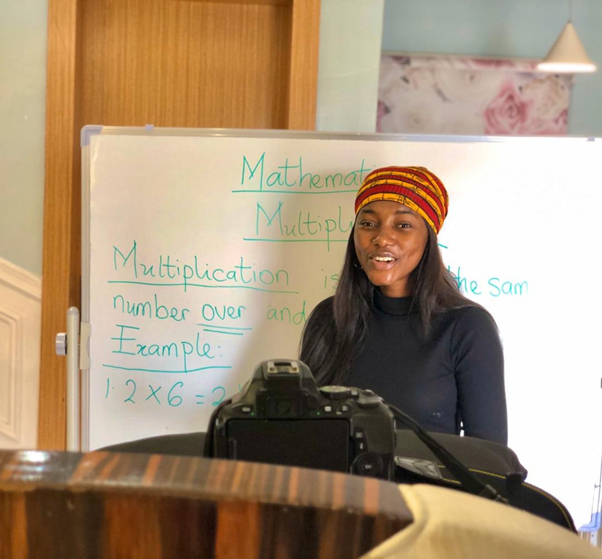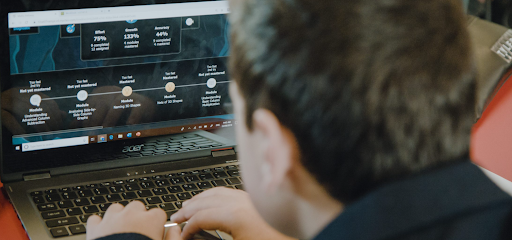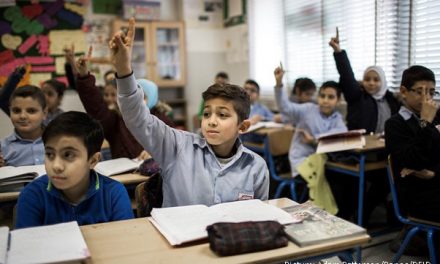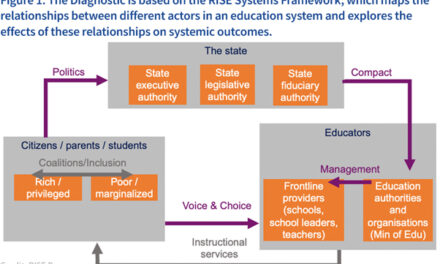This article was written by Wendy Kopp, CEO of Teach for All, and published on the Medium platform on 13 July 2021.
EdTech — education technology — has been the “next big thing” in education for more than a decade. As technology has developed and been leveraged in other sectors, many have been waiting for the moment when it would revolutionize education, disrupting the traditional modes of teaching and learning which have barely changed in decades. We might still be waiting, if it weren’t for the COVID pandemic that shut down schools and forced teachers to find other ways of reaching students when they couldn’t be together in classrooms. Indeed, EdTech became for many the only thing that kept kids learning.
“We’re not going back to how things were before COVID. Teachers around the world have spent the pandemic learning how to leverage technology in their work and creating new online materials. They aren’t about to throw all of that work into the trash and pretend it all didn’t happen.”
And it’s here to stay. As Quim Sabrià, alumnus of Empieza por Educar (Teach First Spain) and founder & CEO of Edpuzzle — a tool for creating interactive video lesson plans which has reached 35 million students and is used in classrooms around the world, including in 80% of schools in the United States — told me: “We’re not going back to how things were before COVID. Teachers around the world have spent the pandemic learning how to leverage technology in their work and creating new online materials. They aren’t about to throw all of that work into the trash and pretend it all didn’t happen.”
There are many great examples of how, when used well, technology is enabling students to take control of their learning and teachers to leverage a whole world of materials and tools to enhance their teaching. The choice we now face is whether we will leverage it as a tool for driving excellence and equity in education, or instead allow digital and teacher skill divides to open up new gulfs between those with access to the best resources for an education that prepares students to thrive in a rapidly changing world, and those without such access, who will be left further behind.
Having spoken with many teachers who leveraged available technology to keep students learning in some of the most under-resourced contexts in the world, and with social entrepreneurs among the Teach For All network’s alumni who invented new technology solutions where they didn’t see them already available, I’ve come to see a path forward for leveraging technology in education and ensuring that it is a force for greater equity and quality. I wanted to share four thoughts on this challenge.
- Technology can be a powerful tool for fostering student ownership of learning, differentiating and personalizing instruction, and making teaching and learning more accessible
One of the biggest challenges teachers in traditional classrooms face is ensuring that their teaching meets the many varied needs of their students. Good teachers differentiate their instruction — meeting students’ different learning levels, enabling them to move at their own pace, and responding to their individual needs and questions. Successfully differentiating lessons is very challenging — particularly in large classrooms! — but while teaching remotely during the pandemic, many more teachers experienced the power of technology to make it easier. For example, Teach For Nigeria teacher Precious Adegunle recorded video lessons for her students during lockdown, sharing the videos over WhatsApp and then engaging with her students individually on their assignments. Like many teachers around the world, she discovered that these videos enabled students to move at their own pace, with those who had a firm grasp on the material moving ahead quickly, while others could watch the lessons as many times as needed to improve their understanding.
Teach For Pakistan fellow Rabiah Chaudhry set up a “WhatsApp School” as a way of reaching her students, most of whom had access to data-enabled phones but not laptops. She sent assignments via class WhatsApp groups and then had her students send their work back via individual chats, allowing her to provide feedback and engage directly with students and parents. “Soon they were sending voice notes with their questions and class discussions started to flow,” Rabiah said. “When I sent them feedback, they would often ask for more clarity and they started to get the sort of individual attention they could not ask for in a classroom of 50 students.” Rabiah found that this also increased her students’ agency over their own learning. Thinking ahead to when the pandemic is finally over, she plans to keep her WhatsApp School going as a permanent part of her teaching, using it to allow students to move at their own pace and to keep parents involved.
Teach For Australia alumni Richard Wilson and Justin Matthys came to this insight about the power of technology to help teachers meet students’ different needs several years ago. They developed Maths Pathway while they were teachers in Melbourne, as a way of leveraging technology to diagnose students’ learning levels and produce learning materials to meet their needs, while also supporting teachers to optimize the time freed up to foster higher order thinking skills. Over the past five years, Maths Pathway has scaled to reach 80,000 students across 350 schools annually in Australia, and has seen students achieve two to three times the amount of progress per year than would typically be expected.
At 321 Education Foundation, an initiative founded by Teach For India alumnus Gaurav Singh to build capacity within schools in India, school closures led to the launch of CAPE, a free online lesson bank optimized for use on basic devices and with limited data connectivity. CAPE includes tried and tested videos, pictures, worksheets, and activities that are packaged as one-page lessons that can easily be shared via WhatsApp and which are aligned to central and state board standards. The shift online enabled 321 to expand from a presence in 70 schools in three cities to over 600 schools in eight major cities and numerous smaller towns, and their data shows that the 30% of students who found a way to access this technology learned at the same levels as they historically did in person. All over the world, we’ve seen the development of similar video and podcast libraries which present the opportunity for students, parents and teachers to access high-quality learning experiences at any time and anywhere.
- We face a massive challenge in ensuring equitable technology access — but we can solve it if we prioritize the right things
The most useful EdTech is not the technology with the most features or the most sophisticated algorithms; it is whatever technology is available to teachers and students. So many discussions about EdTech center around expensive technology, when the reality is that only a small fraction of the world’s kids have access to their own laptop and high-speed broadband connection — either at school or at home. On the other hand, many more families, even in the lowest-resource countries and communities, have access to a smartphone, meaning that very familiar platforms such as WhatsApp and YouTube hold the most promise for the kids who currently have least access to the best educational resources. We would be best served by focusing our energy on enabling students to move up the access ladder.
Talk of the “digital divide” can often sound like a binary of the haves and have nots. In reality, there is a spectrum and students can move from having access to no device, to a basic phone, to a smartphone, to a tablet, to a laptop; and from having no connectivity, to SMS, to slow data, to fast but prohibitively expensive data, to fast, cheap, and reliable WiFi. Each step along the way enables access to more online learning opportunities. Seeing the digital divide as a spectrum enables us to prioritize moving those with the least access forward, knowing that each step will enable more learning than the previous one.
After Precious Adegunle started creating her videos to send to her students, she worked to raise funds to buy her students tablets so that they could watch the videos and interact with her lesson materials freely — rather than relying on what was in many cases the family’s only smartphone.
Discussions around EdTech are often centered on questions such as when machine learning and artificial intelligence will open up new possibilities for individualized learning by predicting how students can master content better than teachers are currently able to do. While the technology may well arrive at that point one day, this prospect is not around the corner.
“Education is not chess. You can use AI for chess, but in my classroom, the kid that had breakfast and the next day went without breakfast, it’s a completely different story.”
Maths Pathway’s Richard Wilson says: “We use some machine learning technology to do things where we can’t answer direct questions,” such as making some predictions about the potential future outcomes of students. “But that’s a really risky thing to use in any irreversible decisions.” He says that Maths Pathway uses the technology to flag things for teachers that they may want to look at, but that teachers should always be deeply involved in determining the learning pathways of their students — they know their students best and no machine learning algorithm can possibly contain all the data points that a teacher has from knowing her students as individuals. This perspective is echoed by Edpuzzle’s Quim Sabriá, who says: “Education is not chess. You can use AI for chess, but in my classroom, the kid that had breakfast and the next day went without breakfast, it’s a completely different story.”
Raghvendra Yadav, a student alumnus of Teach For India classrooms and member of Teach For All’s Student Leaders Advisory Council, collaborated with Teach For India teachers and other students to start ClayLab to enable hundreds of students in his community to continue their learning online during the pandemic. Raghvendra challenges us to ask ourselves the question: “How as a society can we come together to get a smartphone to every family?” While smartphone penetration in Sub-Saharan Africa was 45% in 2019, and is projected to grow to 65% by 2025, that still means that one in three Sub-Saharan Africans still has no prospect of even the most rudimentary online learning in the next few years. If we were able to focus our energy on moving the needle on statistics like this one, we would be making a greater contribution to the advancement of both educational excellence and equity than if we stay focused on questions such as the future of machine learning and AI in EdTech.
- Solving the access issue won’t get us anywhere without investing a lot in teachers
The loudest message I’ve heard from our network’s teachers and alumni educators is that in making the most of EdTech, the technology is the easy part — the harder and more important part is developing strong teacher practice in leveraging it effectively.
Samantha Pratt, who taught fifth grade science with Teach For America in Miami for three years, started KlickEngage as a technology-based resource to bring social-emotional learning into schools. She’s seen tremendous demand for their work during this COVID era, but soon recognized that spreading the technology would not grow their impact without intensive teacher training in leveraging the data to ensure the most appropriate support for students. “We realized technology is not enough,” she said. “Tech is a vehicle, but someone is still driving that vehicle, and if the drivers don’t know where they are going, then we are in trouble.”
“EdTech isn’t always keeping the educator in mind”
Quim Sabriá’s experience at Edpuzzle echoes this point. He has seen firsthand the limitations of his tool — as well designed as it may be, its power is wholly dependent on the skills of the teacher who uses it. “Technology can amplify teaching, either good or bad,” he said. “Technology in the hands of a poorly trained, bad teacher has a very negative impact on students. On the other hand, technology in the hands of a teacher who has been trained and knows exactly how to use it in their instruction can have a huge impact.” As a teacher who created her own tools despite the many EdTech offerings available today, Rabiah Chaudhry echoed this. “EdTech isn’t always keeping the educator in mind,” she says. “We have so many resources, tech labs, tablets, and other fancy things but we haven’t been trained to use them.”
While Richard Wilson built Maths Pathway to leverage the potential of technology, he quickly realized that the power of the approach would rest on teacher development. “We tested the limits of tech very early and we realized quickly it was just not going to get the outcomes we wanted,” he said. “Developing the technology is the easy part. The most challenging part is working with teachers to change their practice.” This is why Maths Pathway focuses much of their time and energy on the in-person work they do in schools to build teachers’ skills in using the time technology frees up to foster their students’ higher order thinking.
- Students and teachers themselves are a vital and largely untapped resource in developing and maximizing EdTech
The founding story of Edpuzzle begins in Quim Sabriá’s classroom in Barcelona, Spain, in 2011. “At that moment, Khan Academy was growing really fast and the use of video was becoming part of teaching practice for many teachers, including myself. However, I started to experience many of the problems that many teachers have when it comes to the use of video. I felt I was reinventing the wheel every week because I couldn’t find high quality content on YouTube that was aligned with the standards I was trying to cover.” It was this recognition from Quim’s classroom experience about the need for teachers to be able to adapt videos into lesson content that led him to found Edpuzzle.
Like Richard Wilson and Quim Sabriá, Michelle Brown began her journey to EdTech entrepreneurship in her middle school classroom as a Teach For America teacher in rural Mississippi. “I used to spend hours and hours going online, looking for texts for my students to read that were worthy of their time and attention — but all I could find were dinky time-filler activities,” she says. It was this frustrating experience that led her to research at graduate school how children develop their language and literacy skills, and then to found CommonLit — a bank of high-quality online reading resources for grades 3–12, which now has over 20 million registered teachers and students across 195 countries and territories.
In order to develop EdTech that fosters both excellence and equity, we need to bring together the technical expertise of software developers with the educators who deeply understand pedagogy and the needs of students and teachers.
In order to develop EdTech that fosters both excellence and equity, we need to bring together the technical expertise of software developers with the educators who deeply understand pedagogy and the needs of students and teachers. It is this tight connection between technical expertise and a focus on improving educational outcomes that led Edpuzzle to move away from success metrics of user numbers and video views — the common yardstick in the industry — towards analyzing data about which of their videos are actually keeping their students engaged and enabling them to learn, and in turn building an ever-more-robust library of their most high-quality videos. At CommonLit, Michelle says: “Our bottom line literally is: ‘Will we close persistent opportunity gaps for children?’ We are just chasing that as the sole thing.”
Entrepreneurs like Quim, Michelle, Richard, and Gaurav aren’t the norm in EdTech. What they all share in common is that their motivation to become EdTech entrepreneurs was born of their experiences as teachers working with the most underserved kids — a motivation which shapes everything they do today. “In my experience, the best entrepreneurs that I’ve seen — the ones who really move the needle for kids equitably, who close persistent opportunity gaps and hold themselves accountable to that — they were people who were in the classroom, and have a real respect for the craft and what it takes to be a teacher today,” Michelle says.
The good news for EdTech companies is that teachers are a ready and available resource who have a lot of energy for ensuring that their students have access to all the opportunities they need to fulfill their potential. Think about Precious Adegunle, who made her own videos because those she was finding on YouTube were mostly from Western contexts. She wanted her students to learn about managing their money in Nigerian naira rather than US dollars, and to learn the names of the parts of a plant using local and both English and Yoruba. There are tens of thousands of similarly determined teachers around the world who, when paired with technology expertise, could fuel the revolution not only in usage rates, but in engagement and learning levels.
During this era we’ve seen incredible innovation from teachers who, without the traditional structures of classes and schools to rely on, stepped outside of the box and created high and low-tech solutions to ensure that their students kept learning.
We need to encourage their creativity and initiative. We also need the rising generation of promising leaders to put their creative energy into classrooms and towards enabling today’s children to use technology to access learning, opportunity, and hope for creating a better world for themselves and all of us — rather than using that energy to find ways to keep our young people’s attention on social media to drive advertising revenue.
As we pioneer the future of education, our starting point shouldn’t be the question of how to maximize technology, but rather the questions of what we’re trying to accomplish and how we can leverage all of the people and technology resources at our disposal to reach that goal.
“Times are tough but every challenge brings a new opportunity. This is our opportunity to reimagine education,” Raghvendra Yadav challenges us. “This does not mean providing digital resources and laptops. It means thinking of students’ outcomes and rethinking the purpose of education.”







I agree with your point that with the help of technology we can actually transform education. With the help of this article, there are many things that one can learn about the importance of technology in the field of education. I am glad that I came across your article. Thank you for sharing all this information with us.